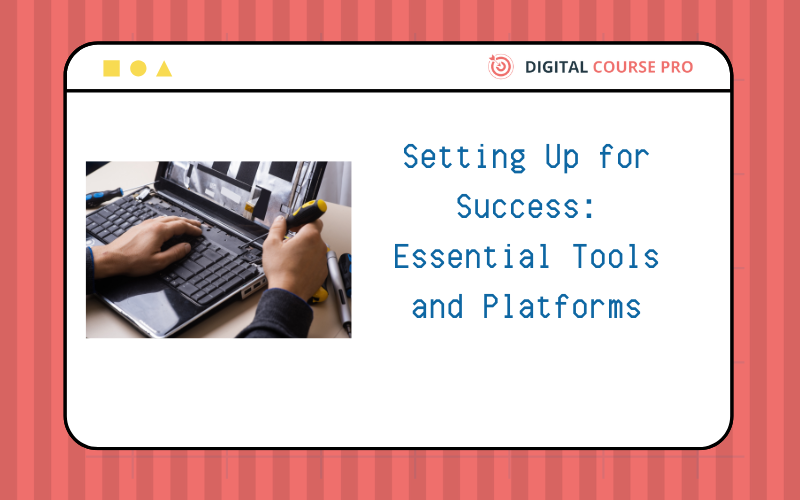Setting Up for Success: Essential Tools and Platforms is the cornerstone of the “10 Steps to Mastering Simply Passive Digital Marketing Course.” This module equips you with indispensable insights and strategies essential for navigating the digital marketing landscape effectively. Whether you’re a seasoned marketer honing your skills or a newcomer eager to learn, this course provides a comprehensive foundation for success. Explore how to leverage key digital tools and platforms, optimize your strategies, and achieve sustainable growth. Begin your journey to mastering digital marketing by exploring our detailed page today.
Website Builders and Hosting Services
- Website Builders:
Website builders are tools that allow individuals and businesses to create websites without the need for extensive coding or technical knowledge. Popular website builders include Wix, Squarespace, Shopify (for e-commerce), and WordPress.com. These platforms offer user-friendly interfaces, drag-and-drop functionality, customizable templates, and built-in features like SEO tools and mobile responsiveness. - Hosting Services:
Web hosting services provide the infrastructure and technologies needed for a website to be accessible on the internet. Key considerations when choosing a hosting service include reliability, speed, security features (such as SSL certificates), scalability (ability to handle traffic spikes), customer support, and pricing. Popular hosting providers include Bluehost, SiteGround, HostGator, and WP Engine (for WordPress-specific hosting).
Content Management Systems (CMS)
- Importance of CMS Platforms:
Content Management Systems (CMS) like WordPress, Joomla, Drupal, and others, simplify the process of creating, managing, and updating website content. They offer features such as content publishing workflows, user permissions, SEO plugins, themes, and plugins/extensions for added functionality. WordPress, in particular, powers a significant portion of websites globally due to its flexibility, scalability, and extensive community support. - Using CMS Effectively:
To effectively use a CMS like WordPress:
- Install and customize themes to match your brand’s aesthetic and functionality requirements.
- Utilize plugins/extensions for SEO optimization, security enhancements, performance improvements, and additional features such as e-commerce or membership sites.
- Regularly update CMS core, themes, and plugins/extensions to ensure security and compatibility with the latest web standards.
- Implement best practices for content organization, SEO-friendly URL structure, image optimization, and responsive design for mobile devices.
SEO Tools
- Essential SEO Tools:
SEO tools help website owners optimize their sites to improve search engine rankings and attract organic traffic. Key SEO tools include:
- Keyword Research Tools: Such as SEMrush, Ahrefs, and Google Keyword Planner, help identify relevant keywords with high search volume and low competition.
- Site Audits: Tools like Screaming Frog and SEMrush conduct comprehensive audits to identify SEO issues such as broken links, duplicate content, and page speed optimization.
- Performance Tracking: Google Analytics and Google Search Console provide insights into website traffic, user behavior, keyword performance, and opportunities for improvement.
Social Media Management Tools
- Benefits of Social Media Management Tools:
Social media management tools streamline the process of managing multiple social media accounts, scheduling posts, and analyzing engagement metrics. Popular tools include Hootsuite, Buffer, Sprout Social, and Later.
- Scheduling: Plan and schedule posts in advance across multiple social media platforms to maintain a consistent presence and reach your audience at optimal times.
- Analytics: Track key metrics such as likes, shares, comments, click-through rates, and follower growth to measure the effectiveness of your social media strategies.
- Engagement: Monitor mentions, hashtags, and messages to engage with your audience promptly and build relationships.
Email Marketing Platforms
- Top Email Marketing Platforms:
Email marketing platforms facilitate list management, email campaign creation, automation, and analytics. Popular platforms include Mailchimp, Constant Contact, ConvertKit, and HubSpot.
- List Building: Create and manage email lists, segment subscribers based on demographics or behavior, and personalize email content to increase engagement and conversions.
- Automation: Set up automated email workflows (drip campaigns) triggered by user actions or dates to nurture leads and drive sales.
- Analytics: Track email open rates, click-through rates, conversion rates, and other metrics to optimize email campaigns and improve ROI.
Analytics and Tracking Tools
- Implementing Analytics Tools:
Analytics tools like Google Analytics and Google Tag Manager provide valuable insights into website performance, visitor behavior, and marketing campaign effectiveness.
- Website Performance: Monitor metrics such as traffic sources, bounce rates, average session duration, and conversion rates to assess website performance and user engagement.
- Campaign Tracking: Use UTM parameters and goal tracking in Google Analytics to measure the success of marketing campaigns, including email campaigns, PPC ads, and social media promotions.
- Custom Reports: Create customized reports and dashboards to visualize data, identify trends, and make informed decisions to optimize marketing strategies.
Graphic Design and Multimedia Tools
- Design Tools for Visual Content:
Graphic design and multimedia tools help create visually appealing content to enhance brand identity and engage audiences effectively.
- Canva: A user-friendly design tool with templates for social media graphics, presentations, posters, and more, suitable for users with minimal design experience.
- Adobe Creative Cloud: Professional design software (Photoshop, Illustrator, InDesign, etc.) for creating high-quality graphics, illustrations, logos, and multimedia content.
- Video Editing Tools: Tools like Adobe Premiere Pro, Final Cut Pro, and DaVinci Resolve for editing and producing video content for marketing campaigns, tutorials, and promotional materials.
By leveraging these tools effectively, businesses can establish a strong online presence, enhance user experience, and optimize their digital marketing efforts to achieve business goals effectively.
Embark on a transformative journey into the world of digital marketing mastery with our “10 Steps to Mastering Simply Passive Digital Marketing Course.” Delve into each step to uncover invaluable insights and actionable strategies that empower you to navigate the digital landscape confidently. Whether you’re an experienced marketer looking to refine your skills or a newcomer eager to learn, this course provides a comprehensive roadmap to success. Learn how to effectively leverage digital platforms, optimize your strategies, and achieve sustainable growth. Don’t miss out on this opportunity to enhance your digital marketing skills. Visit our detailed page now to begin your educational journey today.





